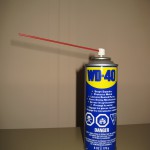In North America, WD-40 is a household name. Nearly everyone has one of the small blue and yellow canisters under their kitchen sink or on a workshop bench in the basement or garage.
Marketed as “The Can with 1,000 Uses,” people often use WD-40 to stop squeaks, prevent rust and remove dirt from hard to reach places. In our house it’s the go-to can for fixing squeaky door hinges and loosening nuts and bolts.
A visit to www.wd40.com reveals other possible applications:
- cleaning and lubricating guitar strings
- erasing crayon artwork from walls
- untangling jewellery chains
- keeping flies off cows
- cleaning bowling balls
- getting peanut butter out of shoestrings
- preventing bathroom mirrors from fogging up
- giving a floor that “just waxed” sheen without leaving it slippery
(Just so you know, the 2,000+ list of potential uses found on the WD-40 website has been compiled from public submissions and in no way implies endorsement by WD-40 or me.)
 The super spray was developed in 1953 by California resident Norm Larsen. As founder of the Rocket Chemical Company, he was looking for a way to repel water and prevent corrosion. His invention was first used to prevent rust and corrosion on the outer skin of the Atlas missile and was available on store shelves by 1958.
The super spray was developed in 1953 by California resident Norm Larsen. As founder of the Rocket Chemical Company, he was looking for a way to repel water and prevent corrosion. His invention was first used to prevent rust and corrosion on the outer skin of the Atlas missile and was available on store shelves by 1958.
But the really interesting thing about WD-40 is its name. The WD stands for water displacement. And the 40 indicates that the formula was Larsen’s 40th attempt. That’s right. He reworked and tested his idea 40 times before creating something marketable. Continue reading “What WD-40 can do for your writing”
